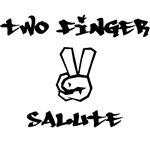
What does the two finger gesture mean in the UK?
The V-sign in British English
The V sign in Britain can be an offensive gesture made by sticking up the index and middle fingers with the palm of the hand inwards as an indication of contempt or defiance. It’s also used in road-rage to indicate annoyance.
The Two Finger Salute Historical Genesis
The origins of the Two Finger Salute are often shrouded in myth and legend, with one of the most popular tales tracing back to the Hundred Years’ War (1337-1453) between England and France. According to folklore, the French threatened to cut off the bow fingers of captured English longbowmen, who were pivotal to the English army’s strength due to their skill in using the longbow. The gesture, showing the index and middle fingers raised with the palm facing outwards, was supposedly used by English archers to taunt the French, indicating that they still possessed their bow fingers. While this story is widely recounted, historical evidence supporting it is scant, and it may well be apocryphal.
Two Finger Salute Evolution and Meaning
Over the centuries, the Two Finger Salute has evolved, both in form and in meaning. In its most recognized form today, particularly in the UK and Commonwealth countries, it is made with the back of the hand facing outward, contrasting with the similar but more universally recognized V-sign for peace or victory, popularized by Winston Churchill during World War II, with the palm facing outward.
The modern interpretation of the Two Finger Salute is complex and context-dependent. It can convey defiance, irreverence, or a dismissive attitude, often used to signal a metaphorical “up yours” to authority or an adversary. Unlike its potentially apocryphal origins, which carried a specific message of resilience and capability, the contemporary usage is broader, serving as a non-verbal expression of strong emotions ranging from disdain to playful camaraderie, depending on the relationship between the individuals involved and the situation.
Societal Impact and Controversy
The Two Finger Salute holds a unique place in British culture and beyond, embodying the fine line between offensive gesture and symbol of cultural identity. Its use in public or towards someone not familiar with the gesture’s nuanced meanings can lead to misunderstandings or be deemed offensive. The gesture’s acceptability varies widely across different contexts and demographics, being more prevalent and tolerated among younger generations and in informal settings.
In media and popular culture, the Two Finger Salute is often employed to convey character traits such as rebelliousness, toughness, or a disdain for convention. However, its use can also spark controversy, particularly when used in contexts where its implications might be misinterpreted or deemed inappropriate.
Two Finger Salute Legal and Social Ramifications
The legal implications of using the Two Finger Salute vary by jurisdiction but can be considered offensive or even a form of disorderly conduct in certain contexts. This variability underscores the importance of understanding cultural and legal norms when interpreting or using gestures with potentially offensive connotations.
Conclusion: A Gesture Transcending Time
The Two Finger Salute is a testament to the enduring power of non-verbal communication, capable of conveying a complex array of emotions and messages without a word being spoken. Its origins, whether rooted in historical fact or fiction, highlight the human penchant for symbolism and the need to express defiance and resilience in the face of adversity.
As society evolves, so too does the language of gestures, with the Two Finger Salute serving as a fascinating example of how historical events, cultural shifts, and social dynamics shape our means of expression. Its continued use and recognition underscore the gesture’s deep-seated position in the tapestry of British slang and its broader significance as a symbol of cultural identity and emotional expression.
In exploring the Two Finger Salute, we are reminded of the rich history and complex interplay of language, culture, and communication that define human interaction. This gesture, with its roots in the medieval battlefields and its place in modern society, offers a compelling glimpse into the enduring nature of symbolic communication and the ever-evolving landscape of linguistic expression.
Browse or website for more British Slang, idioms and cultural quirks.